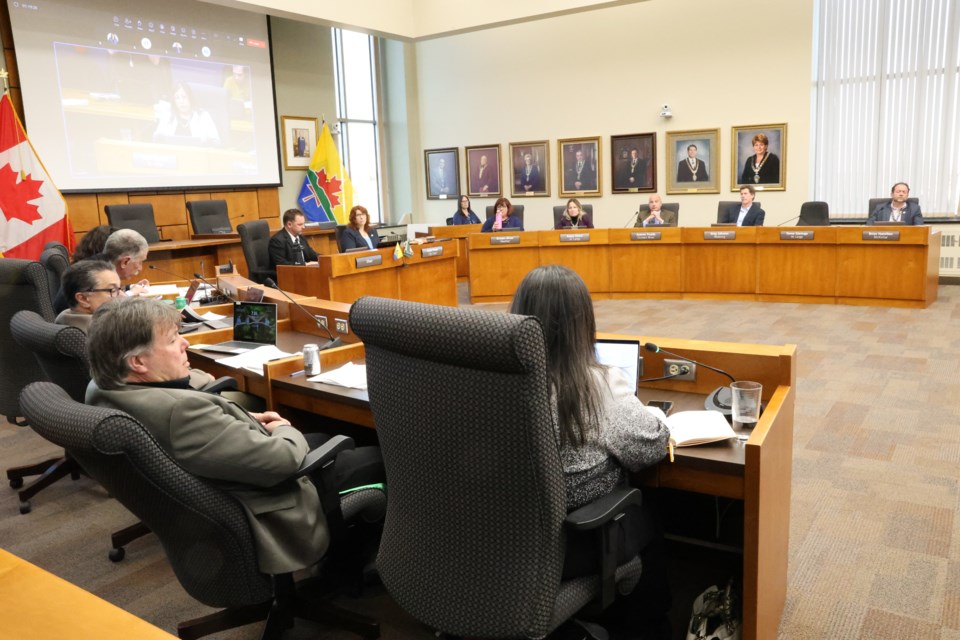THUNDER BAY — A wooded lot on Cumberland Street North, next to the Salvation Army Journey to Life Centre, will likely be the location of the city's temporary shelter village.
Council has told administration to pursue the site on the city’s north side for the development of a planned facility to help address the city's homelessness crisis.
That flew in the face of city staff’s recommended site – a triangular piece of land that is bordered by Fort William Road to the southwest, the Neebing-McIntyre Floodway to the north and the Neebing River to the southeast in the Intercity area. Part of that site is owned by the city, with the other segment owned by the Lakehead Region Conservation Authority.
At its Monday meeting, council was being asked to approve that site so administration could enter into a lease agreement with the LRCA, pending approval from the authority’s board. Instead, Coun. Mark Bentz proposed focusing on another property that city staff also valued highly in its screening of dozens of potential sites across the city for the village.
“At least on the Cumberland site, the investment we make into that property stays with the taxpayer,” Bentz said, referring to the fact that his proposal is using land that is fully city-owned. “It's an investment, it’s not a cost, because that property will be improved.”
A lot of opposition to the Intercity site by some members of council was due to concerns they said they were hearing from businesses and residents nearby.
“I spoke to various large box store owners today, managers and store owners, and (they) said in the summer, when the encampments are larger, their thefts are triple and it's not coming out of a corporate bank account,” said Coun. Rajni Agarwal, adding that she’s aware that not all thefts are committed by those who are unhoused. “It's coming out of each owner's bank account — the corporations are not taking the losses.”
City staff said the village is a structured environment that provides basic necessities for survival — unlike an encampment.
“There is no evidence that crime will increase, none — there is no factual evidence to suggest that,” said city manager John Collin.
“In fact, a number of people who are experts in the field would suggest that the likelihood of crime may very well decrease because those who are being supported are being supported properly and are not starving.”
Some on council also expressed concern about the recommended site being so close to waterways, given the city’s history with drownings and other associated tragedies. However, city staff said many existing encampments are located near water, and have been for several years with no water-related injuries or deaths. Rilee Willianen, the city’s encampment response plan lead, added that the village will have measures like gated fencing, on-site supervision and security.
Monday’s debate was the latest step in council trying to secure a location for the temporary village initiative. In October 2024, city council voted unanimously to approve a 10-part human rights-based plan for responding to homeless encampments; the temporary village was one of those points.
Two sites were then identified, with a vacant lot on Miles Street East being recommended, but ultimately voted down after public backlash. Council then asked administration to bring them an extensive list of all potential sites across the city, with the Fort William Road site being recommended after an extensive analysis using nine criteria, including proximity to support services, readiness for construction and how close they are to existing or known encampment areas.
Councillors who supported Bentz’s site selection pointed to benefits to the Cumberland Street site, including that it’s still on a main transit route and it’s close to relevant services at Salvation Army (although the Journey to Life Centre doesn’t allow substance use, whereas the shelter village, as a low barrier space, would).
The property, however, needs “extensive” site preparation to be usable, according to administration’s analysis, as it’s essentially a tree-filled lot.
Some on council, including mayor Ken Boshcoff, expressed concern that any delays could cost the city $2.8 million in funding from the District of Thunder Bay Social Services Administration Board for funding toward the construction of the village – that funding comes with strict timelines, including construction needing to start in July.
“I do not believe the risks of losing the funding is more pronounced on one lot over the other, so I do not believe it is a significant consideration in terms of council's direction to administration,” Collin said in response to Boshcoff. How the new site selection could impact other pots of money the city is pursuing for the project, Collin said he wasn’t completely sure, but he added he didn’t believe it would be a problem.
Collin said before construction can begin, the city has to issue and finalize two requests for proposals — one for a contractor to build the village and one for an operator to essentially manage it once it’s built. He added that there will also be public engagement efforts.
The vote to ratify the Cumberland Street site is scheduled for its April 14 meeting. Coun. Kasey Etreni is expected to present an amendment formally designating council’s wish to have the LRCA-owned property as a secondary option, should development not be possible at the Cumberland Street site.
